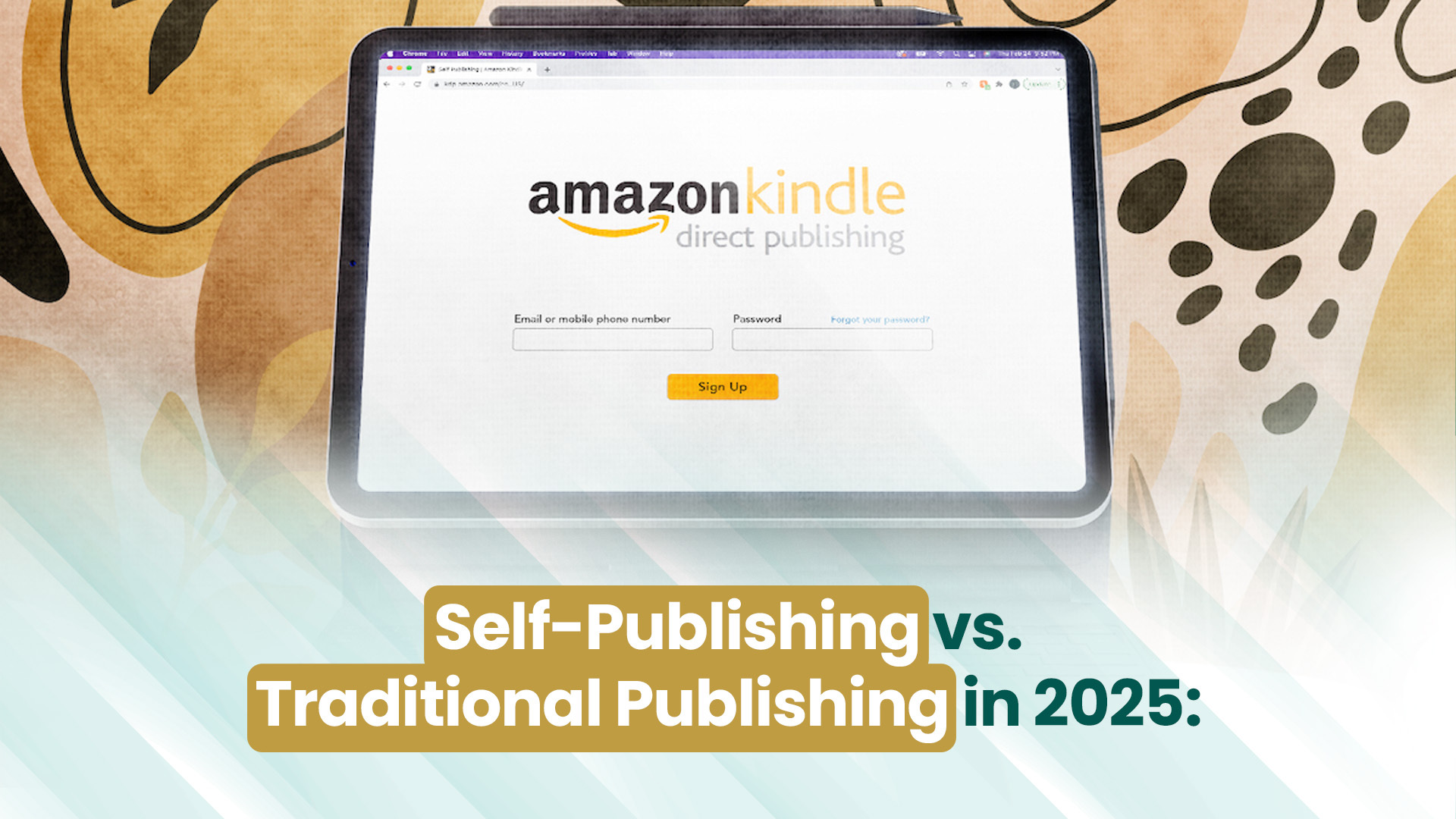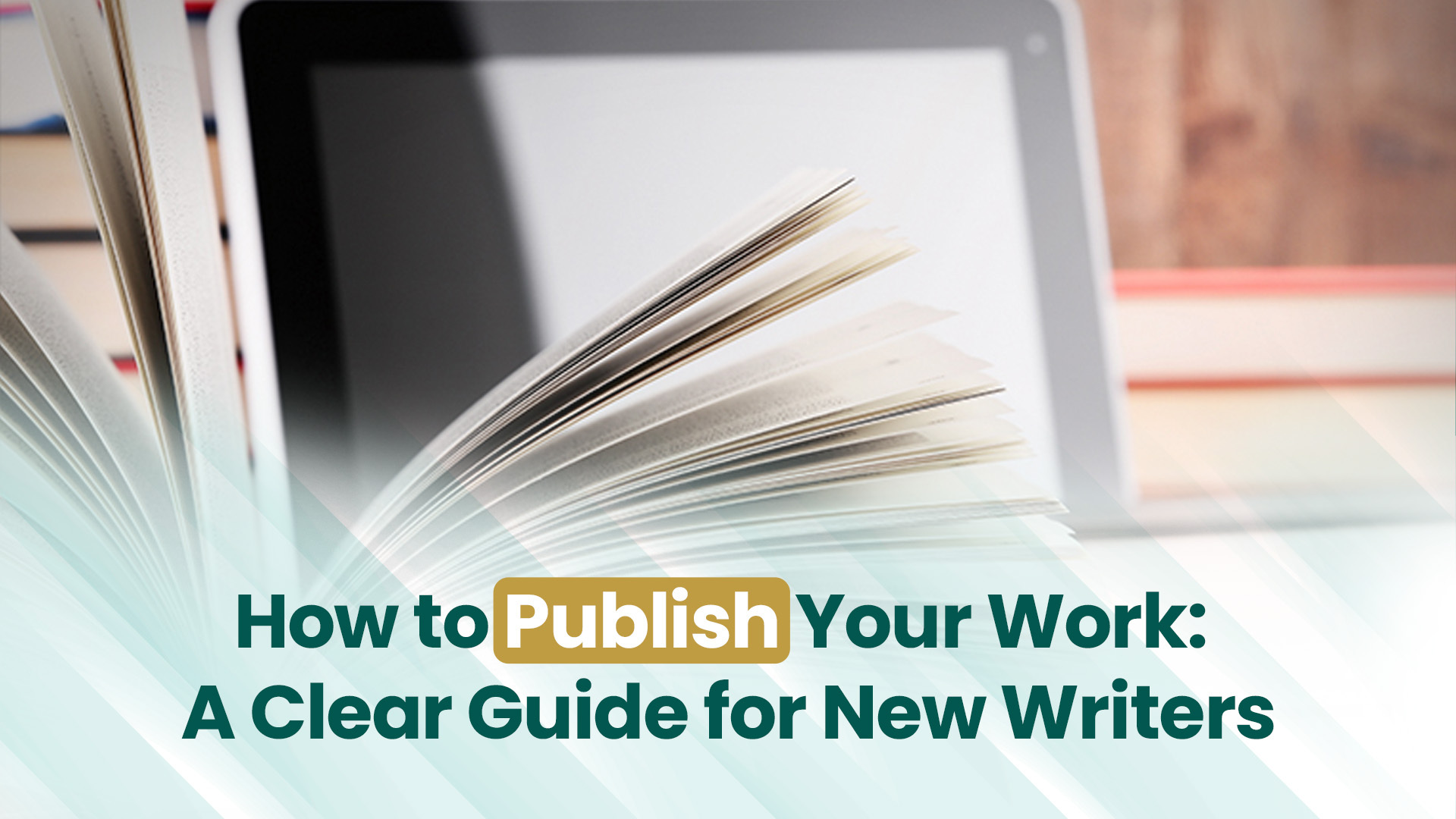Table of Contents
ToggleYou have written something you care about. Maybe it is a novel, maybe poems, or a true story from your life. You spent nights typing, deleting, trying again. Now the pages are done. You look at them and wonder what comes next.
You want people to read it. You want to see your name on a book cover. You want to feel that moment when you hold your own book in your hands.
This is where most writers stop. They wait for someone to say yes. A publisher, an agent, a company. But the truth is, you don’t have to wait anymore.
You can publish your own book. That is what self publishing means. It is when you take your story, prepare it, design it, and share it with readers all by yourself. You do not need anyone’s permission. You decide how it looks, where it sells, and how much it costs.
It might sound hard, but it isn’t as scary as it seems. You just need to know the way. How to publish a book, where to upload it, how to make a good cover, and how to let people know your book exists.
This article will show you all of that. Step by step. No confusing words. No retired tricks. Just real advice that helps you turn your story into a book you can be proud of.
Take a deep breath. You formerly did the hardest part when you wrote it. Now let’s get it out into the world.
Self Publishing vs Traditional Publishing
| Detail | Traditional Publishing | Self Publishing |
| Who controls the book | Publisher | You |
| Time to publish | Long, sometimes years | Short, a few weeks |
| Royalties | Around 10 to 15 percent | Around 35 to 70 percent |
| Rights | Publisher owns | You own everything |
| Flexibility | Low | High |
Understanding Self-Publishing
Let’s start with the basics.
Self publishing means you take charge of your own book. You do not wait for a company to choose you. You become the publisher yourself. You decide everything from the words to the cover to where it is sold.
That might sound big, but it is actually very doable. Many authors all over the world now use this path. Some of them started small, just like you, and now sell thousands of copies.
There are many reasons why writers pick self-publishing instead of traditional publishing. Here are a few simple ones.
Why Authors Choose Self-Publishing
Freedom
You make all the choices. You can change your cover, edit your textbook, or adjust your price anytime.
Speed
You don’t need to stay for hours. You can publish your book in just a few weeks.
Control
You keep your story exactly how you want it. No one changes your words or title.
Earnings
You get a bigger share of the plutocrat from each trade. Most platforms pay around 35 to 70 royalties.
Learning
You understand the whole process, and that knowledge stays with you forever.
Common Myths About Self-Publishing
| Myth | Truth |
| Self publishing is only for people who failed to get a deal | Many bestsellers are self published now |
| It costs a lot of money | You can start small and invest slowly |
| It looks unprofessional | With good editing and design, your book can look amazing |
| It is hard to do | The steps are easy once you know them |
Steps to Self Publish a Book
So now you know what self publishing means. The next question is simple: how do you actually do it? Furthermore, you can also opt for professionals and ask them for advice on how to publish my book.
Let’s take it step by step.
Step 1. Finish and Edit Your Book
Before you publish anything, make sure your book is ready. Read it again properly. Fix small mistakes. You can ask a friend to read it too. Sometimes, another person can see what you missed.
Still, hire a good editor if you can. It helps a lot. But if that’s not possible, use online tools for spelling checks and read your work out loud. When it sounds smooth, it’s ready.
Tip: Keep your style simple and honest. Readers connect more with simple language than complex words.
Step 2. Format the Book
Formatting means setting up the runners so your book looks right on screen and on paper.
- For ebooks, the textbook should adapt to phones, tablets, and Kindle devices.
- For print books, you must set perimeters, runner size, and distance.
If this sounds confusing, don’t worry. Platforms like Amazon Kindle Direct Publishing (KDP) and IngramSpark have free templates. You just upload your book and follow the guide.
Step 3. Design a Good Cover
People really do judge a book by its cover. If you can, get a designer. If not, use simple free tools like Canva or BookBrush.
Your cover should:
- Look clean and clear
- Show the title and author name clearly
- Match the mood of your story
Think of the covers of books you love. What do they have in common? Try to follow that feeling.
Step 4. Choose Where to Publish
This part is exciting. You can publish your book on one or many platforms.
Here are some popular ones:
| Platform | Type | What It Offers |
| Amazon KDP | Ebook + Print | Free to use, global reach, quick updates |
| IngramSpark | Print + Ebook | Great for bookstores, small fee |
| Draft2Digital | Ebook | Easy distribution to Apple, Kobo, and others |
| Smashwords | Ebook | Simple upload, wide audience |
You can start with Amazon KDP first. It’s easy and free. Then, once you learn more, expand to others.
You can also get help from the Professional Book Publishing Company if you want full support with formatting, design, and uploading.
Step 5. Set the Price
This part is over to you. Ebooks frequently sell between $ 2.99 and $ 9.99. Published books depend on size and printing cost. Still, start with a lower price to attract customers if you’re new. You can always change it later.
Platforms like KDP also display your royalty rate (for example, 70% for ebooks priced between $ 2.99 and $ 9.99).
Step 6. Upload and Publish
Now comes the delightful part. You upload your book idea, cover, and details like title, author name, and description. Double-check everything before hitting publish.
After that, your book goes live within 24 to 72 hours. Congratulations, you’re a published author.
Take a moment to enjoy it. You did it yourself.
How to Market and Promote Your Self Published Book
You have published your book. That’s a big step. But now comes the part that many authors forget, which is letting people know it exists.
Even the best story needs eyes on it. Marketing doesn’t have to be scary or expensive. It just means sharing your book with the right readers in simple, real ways.
Let’s look at how to do it.
Step 1. Start Small and Real
Tell the people you know first. Friends, family, co-workers, anyone who might be happy for you.
Share your story on your social media. Post about what inspired the book. People love seeing the journey behind it.
Don’t try to sound like an ad. Just be yourself. A simple message like:
“I finally published my book! It’s live on Amazon today. I’d love for you to check it out.”
That’s enough. Honest words connect more than perfect marketing lines.
Step 2. Create an Author Page
If you are using Amazon KDP, set up your Amazon Author Page.
It lets readers see all your books, a short bio, and your photo. You can also share updates and link your website.
You can make one here: Amazon Author Central
If you have your own website, you can also link your homepage, for example, Professional Book Publishing Company, to show your work or offer help to other writers.
Step 3. Get Book Reviews
Reviews help a lot. They tell new readers that your book is worth reading.
You can:
- Ask friends who read your book to leave honest reviews
- Offer a few free copies to people in exchange for feedback
- Join book groups on Facebook or Reddit and share your story there
- Never pay for fake reviews. It can hurt your account. Just aim for real people sharing real opinions.
Step 4. Use Social Media Slowly
Pick one or two places where you feel comfortable, maybe Instagram, TikTok, or X (Twitter).
Post small things like:
- Your writing routine
- Quotes from your book
- Photos of your book on a table or shelf
- Short videos of you talking about your writing
You don’t need to post daily. Even once or twice a week helps. Readers like seeing the face behind the story.
Step 5. Try Free and Paid Promotions
Once your book is live, you can join free or low-cost promos.
Here are a few:
| Platform | Type | Notes |
| BookBub | Paid promo | Great reach but needs budget |
| Goodreads | Free | Build a profile, join book clubs |
| Reedsy Discovery | Paid | Helps indie authors get early readers |
| Facebook Ads | Paid | Can target specific readers |
Start with small quantities and see what works. You do n’t have to spend a lot.
Step 6. Make a Small Dispatch List
This is something most authors forget, but it really helps. Still, they might want to know when you write the next one, if someone loves your book. You can use simple tools like MailerLite or Substack to collect emails from readers who want updates.
Keep it real. Tell them what you’re working on or thank them for reading.
Mistakes to Avoid in Self-Publishing
Every new author makes mistakes. That’s okay. You are learning. But knowing what to watch out for can save you a lot of stress and money.
Here are the most common ones and how to avoid them.
1. Rushing the Process
Many writers get excited and publish too soon. They finish writing and hit publish the next day. Slow down. Take time to check everything like grammar, layout, and the cover.
2. Skipping Professional Help
You don’t need to spend thousands, but you also shouldn’t skip help where it matters.
A good editor or cover developer can make your book look professional. Still, look for affordable freelancers or ask for recommendations in pen groups, if you can’t go.
You can also reach out to Professional Book Publishing Company for guidance or low-cost publishing support.
3. Poor Book Cover Design
Your cover is the first thing compendiums see. However, people may skip your book, indeed, if the story is great, if it looks messy or unclear. Avoid too numerous sources, dark images, or irrelevant titles. Keep it simple and neat. Suppose you like covers and learn from them.
4. No Marketing Plan
Publishing your book is just step one. Numerous new authors stop there. They suppose the book will sell itself. Sadly, it doesn’t. You need a plan, indeed, a small one. Decide where you’ll post, who might read your book, and how you’ll share it. You don’t need fancy advertisements. Indeed, many posts a week or joining one anthology group helps.
5. Ignoring Formatting and Layout
If your pages look odd or words run off the screen, readers will leave bad reviews.
Use the free templates on Amazon KDP or IngramSpark. Always preview your book before publishing. Formatting might seem boring, but it’s what makes your book look clean and readable.
6. Pricing Too High or Too Low
Some new authors set their prices too high in an attempt to earn more. Others go too low, hoping to get readers fast. Both can hurt your sales. Start simple. A price range of around $2.99 to $4.99 is generally considered a good ebook price for first-time authors. You can always adjust it later.
7. Not Building a Reader Base
Your first book is just the start. Many authors forget to stay in touch with their readers after publishing. Keep posting updates. Build a small email list. Talk about your next project.
Readers remember authors who stay connected.
Smart Habits vs Mistakes
| Smart Habit | Mistake |
| Editing and proofreading | Rushing to publish |
| Simple clean cover | Cluttered or unclear design |
| Having a marketing plan | No promotion at all |
| Testing formats | Uploading without checking |
| Staying connected | Disappearing after launch |
Best Platforms and Tools for Self Publishing
When you decide to self publish your book, the next step is choosing the right tools.
You don’t need everything. Just the ones that help you get your book ready and in front of readers.
Here are the platforms and tools most authors use.
1. Amazon Kindle Direct Publishing (KDP)
Most new authors start here. Amazon KDP lets you publish ebooks and paperbacks.
It’s free and your book can reach readers almost anywhere.
You set your price. You can change it anytime. You can even check your daily sales.
Why it’s good
- Free to use
- Quick publishing
- Big global audience
- Up to 70% royalties
2. IngramSpark
If you want to sell print books in bookstores or libraries, IngramSpark is a great choice.
There’s a small setup fee, but the quality is really good.
Why it’s good
- Excellent print quality
- Bookstore and library distribution
- Good for hardcover or color books
Many authors use both KDP and IngramSpark. KDP for Amazon. IngramSpark for bookstores.
3. Draft2Digital
Want your ebook on Apple Books, Kobo, or other stores? Draft2Digital makes it easy.
Upload once. They send it to multiple stores.
Why it’s good
- Simple and easy to use
- Free to convert and format
- Reach more readers
4. Reedsy
Reedsy is for authors who need help. Editors, cover designers, or formatting experts.
You can hire people for what you need, even if you are new.
Why it’s good
- Trusted professionals
- Easy to find reviews and compare prices
- Helps your book look professional
5. Canva
Need a cover or social media image? Canva is simple.
You don’t need design experience. Just drag, drop, and adjust.
Why it’s good
- Free and easy
- Make ebook covers, bookmarks, or promos
- Works on computer or phone
6. Writing Tools
For writing and editing, use what feels comfortable. Google Docs is free and easy to share. Scrivener is good if your book has many chapters.
Why it’s good
- Keeps your work organized
- Easy to track changes
- Helps with big projects like a novel
Get Extra Help
If you ever feel stuck, there is no shame in asking for help. The Professional Book Publishing Company can help with formatting, cover design, or uploading your book. They make self publishing less stressful, especially if it is your first time.
How to Make Money and Build a Long-Term Author Career
You published your book. That’s amazing. But now comes the part many new authors wonder about. How do you actually make money? And how do you keep going as an author?
The good news is you can do both. It just takes some planning and patience.
1. Understand Royalties
When you publish your book, you earn money from every sale. Platforms like Amazon KDP pay you royalties, which is a percentage of the price. For ebooks, the typical range is 35% to 70%. For print books, it depends on the printing cost. Even small sales matter. A few copies a week can slowly add up.
2. Write More Books
One book is just the start. Most authors make money by writing more. If readers like your first book, they will want another. A series or multiple books helps you build a loyal audience. Think of your first book as the door, and the next books as the path people walk on.
3. Promote in Small Steps
Marketing does not have to be scary or expensive.
- Tell friends and family about your book
- Post small updates on social media
- Share interesting things about your writing journey
- Build a simple email list for readers who want news about your next book
- Little actions like these make a difference over time.
4. Offer Freebies or Discounts
Sometimes giving a book for free or at a small discount helps a lot. A free ebook for a few days can bring new readers. Discounts on print books can also increase sales and reviews.
5. Keep Learning
Publishing changes all the time. New tools, new platforms, new tips appear constantly.
Read blogs, watch videos, and join author groups. Even small changes can help your book reach more people.
Growing as an Author
| Step | Why It Helps |
| Write more books | More readers, more income |
| Promote a little each week | People see your book |
| Offer free or discounted copies | Attracts new readers |
| Build an email list | Readers come back for your next book |
| Keep learning | Stay updated and improve |
Conclusion
Self publishing is not just about putting a book online. It is about taking your story and sharing it with the world. Yes, it takes effort. You need to edit, format, design, and promote.
But every step is doable. Every step is in your hands.
Here’s what matters most:
- Take one step at a time
- Focus on finishing your book first
- Keep learning and improving
- Write more books to grow your audience
- Celebrate small wins along the way
You don’t need anyone to say yes. You are the author. You are in control. Your story matters. Your book can exist. Readers are waiting for it. So take a deep breath. Pick up your manuscript. Pick a platform. Hit publish. It will feel scary at first. But it will also feel amazing.
Your first book is just the start. Keep writing. Keep publishing. Keep sharing your story.
FAQs About Self Publishing
Here are some questions new authors often ask about self publishing.
1. How long does it take to publish my book?
It can be fast or slow, depending on how ready your book is. An ebook can go live in many days. A print book might take a couple of weeks. The most of the time is spent on fixing typos, formatting, and making a good cover.
2. Do I need a lot of capital?
Not really. You can start small. Editing, cover design, or marketing can cost a bit if you hire someone, but there are free tools too. Indeed small ways help you look professional.
3. Can I publish my novel, bio, or any book?
Absolutely. Novel publishing works for stories, runes, biographies, and nonfiction. The procedure is substantially the same.
4. Should I hire help?
It depends on your confidence and budget. Even one editor or cover designer can make your book look professional. Or you can get full help from a Professional Book Publishing Company.
References
- Amazon Kindle Direct Publishing. Self-Publishing Help & Resources.
https://kdp.amazon.com/en_US/help/topic/G200635650 - IngramSpark. How to Self-Publish a Book.
https://www.ingramspark.com/blog - Reedsy. How to Self-Publish a Book: Step-by-Step Guide for 2025.
https://blog.reedsy.com/guide/self-publishing/





